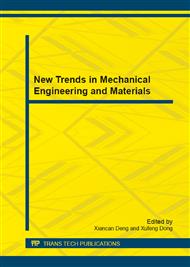p.101
p.104
p.111
p.114
p.119
p.124
p.129
p.134
p.139
Multi-Axis Vibration Power Generation Device for Automobiles
Abstract:
In achieving the practical use of vibration power generation, the challenges are that the energy to be generated is small and the vibration frequency range for efficient power generation is limited. So, it is needed to improve the output level and establish a vibration transmission structure capable of covering a wider vibration frequency range. In this report, we propose a multi-axis vibration power generation device that is mounted on the vehicle and capable of generating electric power from vibrations in the running vehicle and evaluate its principle model based on the stress analysis. For the model, we employed the structure in which the elastic body (a flat spring with piezoelectric elements on it) is deflected by mass vibration and the elements are bent and strained. We made two types of the principle models using the same elastic body; one is H-type having a mass on both sides of the elastic body, and the other is T-type having a mass on one side only, and conducted tests for the system identification of them.
Info:
Periodical:
Pages:
119-123
Citation:
Online since:
December 2012
Price:
Сopyright:
© 2013 Trans Tech Publications Ltd. All Rights Reserved
Share:
Citation:


